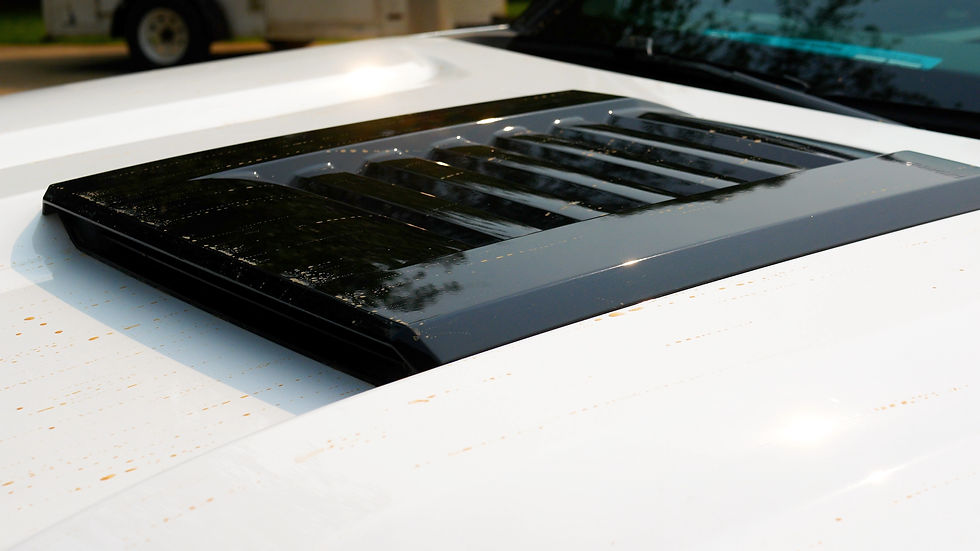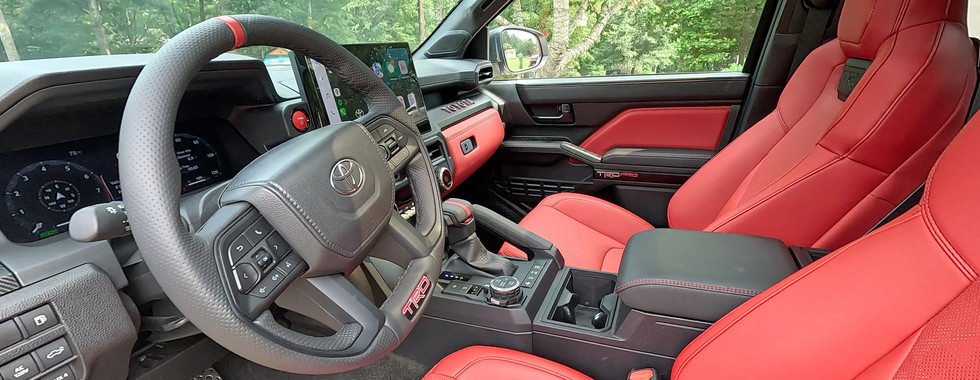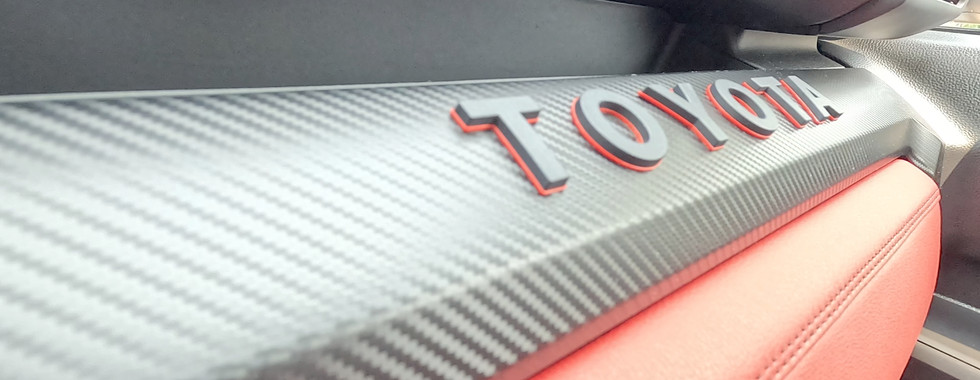Reviewed: The 2025 Toyota Tacoma TRD Pro – With Big Capability Comes a Big Price.
- The Driver's Line

- Jun 24
- 8 min read
by Greg Karpinski

The Tacoma traces its lineage directly to what was perhaps the most un-killable truck of all-time, the Hilux, which was notorious for being able to withstand abuse, harsh climates and even some intentional attempts at destruction and find a way to keep on trucking. That earned reputation led to the Tacoma having one of the highest resale values in automotive history, with one Redditor amazed by the fact that their Tacoma with a $28k MSRP was still worth $26k nearly 80,000 miles and six years later. Certainly, inflation has played a role, but that’s seriously impressive.
That brings us to our tester, the 2025 Tacoma TRD Pro. Toyota unveiled the fourth generation of the Tacoma in 2024, including three performance off-roady trims: the TRD Off-Road, the overlanding-focused Trailhunter and our top-spec TRD Pro, a natural rival to our 2024 Truck of the Year, the Ford Ranger Raptor. With a starting MSRP of $63,735, the TRD Pro starts more than $7,000 higher than the Raptor and has nearly 80 fewer ponies under the hood. Can it still manage to unseat our Truck of the Year? Read on to find out.
The Fine Print: Toyota wanted to see what we thought of their 2025 Tacoma TRD Pro so badly, they dropped it off with a full tank of gas and explicit instructions that we let everyone know this was a press loan from Toyota Motor North America. I think we forgot to tell the Jeep guys on the Wolf’s Den Trail, so this might be our last presser from Toyota. D’oh.

The Tacoma remains the heavyweight of the mid-size truck segment – with its strong reputation for durability and retaining value, it outsold the Ranger in 2024 at a clip of more than four to one. With over 190,000 sales last year, the Tacoma outsold its closest competitor, the Chevrolet Colorado, nearly two to one. It is, undeniably, the 600-pound gorilla in the segment. These sales figures are rather unsurprising to pretty much anyone with eyes – the Tacoma far outnumbers any other midsize truck on roads in the United States.

Our 2025 Tacoma TRD Pro arrived finished in Ice Cap (white) and, with the gloss black roof, hood scoop, fender flares, 20-inch LED lightbar integrated into the retro grille, ARB rear bumper and other accents sitting on the 33-inch Goodyear Wrangler Territory RT tires, it absolutely looks the business. Like a scowling Storm Trooper, our Tacoma was easy to spot in parking lots and dared anyone to cross into its imposing path on the road. Visually, Toyota nailed the aesthetic for this segment – the truck looks purposeful, athletic and ready to tackle any trail or baja desert stage. For 2025, TRD Pros remain only available as a crew cab with a five-foot bed and updates from the 2024 model are minimal – a new color, Mudbath, ensures your truck will exit any trail looking the same as it entered and, for a bit of extra visual flare, Toyota has updated the truck with red recovery hooks. Given the fourth generation Tacoma debuted just last year, few updates were expected.

Even with a killer design, we did take issue with a couple elements: the hood scoop is non-functional and looks lifted straight out of a Pep Boys catalog and the additional height it adds to the hood limits forward view when navigating a tight trail or parking lot. At speed, the metal on the hood flops around like a fish out of water – not really the visual you’re looking for after dropping nearly $70k on a pickup. The last quibble is also rather minor – the rear side windows are rather small – they add forward weight to the design while also creating a larger blind spot than is necessary, while also making an already tight back seat feel that much more claustrophobic.

Inside… well, getting inside is the first challenge. With roughly 11.5 inches of ground clearance, the TRD Pro requires a big step up to get into the driver’s seat, which doesn’t come with any sort of a grab handle. Given that Toyota doesn’t want to limit the breakover angle, running boards or side steps are nonexistent. The trick IsoDynamic Performance seats also sport larger bolsters, which you need to maneuver around, and this contortionism almost always results in bonking your head on the doorframe or your knee on the dashboard or steering wheel when hoisting yourself into the truck. Much like a Lotus Elise, there is no way to gracefully get into the vehicle.

Once actually inside, the interior for the front passengers is pretty great and the comfort and support offered by the IsoDynamic Performance Seats is outstanding. Our tester came with the Cockpit Red SofTex which helps the interior feel much more open and is complementary to the red interior detailing found on all TRD Pros. The TRD-specific steering wheel has a nice thickness and includes a red center stripe that matches nicely with the gear selector that does the same. The quality of materials are a nice step forward for the Tacoma and chunky switchgear, dials and buttons have positive feedback and can be easily used when wearing work gloves. All the latest tech is here and the TRD Pro makes use of a 12.3-inch configurable digital gauge cluster and 14-inch multimedia touchscreen with CarPlay and Android Auto. The best news is that functions like climate control, seat heating/cooling and all the things that should have buttons actually have buttons. Rarely is there a need to dig through menu after menu to adjust a setting. JBL Audio provides the tunes through a 10-speaker system and a trick removeable Bluetooth speaker on the dashboard – if you’re headed out to the beach or campground, you can pop that out of the dash and take it with you, then pop it back in once you’re done and the truck will recharge it.
In the rear seats, the experience starts to fall apart – all Tacomas are tight on rear seat space, but the TRD Pro is so tight that it may as well not even have seats back there. The IsoDynamic Performance Seats eat up at least 2-3 inches of legroom from rear seat passengers and, once you’re in there, the front seats go so low to the floor, your feet have a very small place to reside. Trucks equipped with the iForce Max hybrid system also lose valuable rear underseat storage, as that space is consumed by the 1.87kWh battery. This space could be better utilized as interior storage for gear instead of an uninhabitable back seat.
On the road, much like the Ranger Raptor, the TRD Pro surprisingly shines. Despite the higher center of gravity and chunky 33-inch tires, steering is unexpectedly sharp, reminiscent of a sporty SUV. This is largely due to Toyota’s excellent new TNGA-F truck platform, which is shared with the 4Runner, Land Cruiser and Lexus GX, among others. At the limit, it’s prone to understeer and the 2.5-inch FOX QS3 internal bypass shocks make for a rather firm, but well damped ride, with manual adjustment over three settings for compression stiffness. Given the TRD Pro is designed for desert running, Toyota has calibrated the springs and swaybars for high-speed handling and it clearly shows. Driving down the road, the quiet of the cabin and gentle hum of the tires is only disturbed when the growling 2.4L four-cylinder turbo kicks down a gear.

That brings us to Toyota’s iForce Max hybrid system – it sandwiches a 48hp electric motor between the 2.4L turbo four and an eight-speed automatic, which then puts power to the ground through a two-speed transfer case and an electronically-locking rear differential. The 326hp and 465lbft of torque generated by this powertrain dwarf the 278hp and 265lbft of torque from the old 3.5L V6 and make the roughly 5100-pound truck somewhat sprightly, sprinting to 60mph in 7.1 seconds and tripping the lights through the quarter mile in 15.4 seconds at 87mph. While much improved over previous Tacos, that’s still a rather far cry from the less expensive Ranger Raptor, which hits 60 in 5.8 seconds and runs the quarter mile in 14.5 seconds at nearly 95mph. Unsurprisingly, where the TRD Pro shines relative to its classmates is fuel economy – the EPA rates it at 22mpg city, 24mpg highway and 23mpg combined, well above the 16mpg city and 18mpg highway the Ranger Raptor can manage. While towing and payload may not be at the top of mind for someone buying one of these highly-capable offroad trucks off the showroom floor, the TRD Pro is again best in class – it can haul a maximum load of 6000 pounds and has a payload capacity of 1680 pounds.

While we don’t have deserts in North Carolina for high-speed baja action, we do have an awesome resource in the Uwharrie National Forest, located in Montgomery County. In addition to hiking, boating and the usual recreational activities, the Uwharrie National Forest also offers Off-Highway Vehicle (OHV) trails. A lot of them. So, we loaded up the Tacoma TRD Pro and headed over to the national forest where, for the princely sum of $5.00, you can buy a day pass for all the OHV trails. Compared to roughly $300 per day for a track event, this off-roading stuff is starting to make a lot of sense!
Though the TRD Pro is designed for high-speed desert running, it’s completely at home on a trail, even with off-roading plebes like us behind the wheel. The TRD Pro ate up everything the Wolf’s Den trail threw at it – mud, rocks and spaces that required tight maneuvers. The 11.5 inches of ground clearance and adjustable FOX QS3 shocks never were challenged, and we only had to make use of the FOX internal floating piston hydraulic bump stops once, which cushioned the blow coming down off a surprisingly large rock. We primarily spent our time in four low, with the rear differential locked and front swaybar disconnected, all of which was accomplished from the comfort of the cabin, and what comfort it was.
This is the part where the IsoDynamic Performance Seats start to make a ton of sense. We unlocked the seats to allow the air over oil shock absorption system to manage our vertical and lateral motion and it’s honestly amazing how well they work. Unsurprisingly, the seats simply reduce the shock from the harshest terrain and make it easier to keep your head upright and feet comfortably on the pedals. It didn’t seem particularly fair that we were able to traverse those trails with our automatic climate control set, sitting in ventilated thrones with their own shock absorption system while the Jeep boys and girls sweated on that 90 degree day, but Jordan said discomfort is a Jeep thing and I wouldn’t understand.
The other game changer for the TRD Pro is Toyota’s 3D Multi Terrain Monitor, which allows you to see everything. If anything on a trail surprises you, it’s because you weren’t paying attention, or forgot to turn your cameras on. About halfway through Wolf’s Den, we ran across some stairs with a couple boulders in the path and a choice – right or left. Left looked better suited to a highly-modified Wrangler whereas right was going to be tight, even for our midsize truck. The terrain monitor let us know exactly where to place each tire and how to get the Tacoma’s precious sheetmetal around the obstacles unscathed. We wrapped up our time at the Uwharrie National Forest with a trip around the Lake View Trail and, back at the trailhead, simply switched the truck back into two high, unlocked the rear diff and reconnected the front swaybar at the push of three buttons and drove off. The off-road performance envelope of this truck is something to behold and has us eyeing the Trailhunter, which would be even better equipped to tackle these trails.

Leaving the National Forest, the complaints were few – an automatic 4WD setting would be nice but isn’t necessary. The large hood and non-functional hood scoop limit the view on the trails, but the excellent camera system compensates for it. Steel skidplates and rock rails would offer more protection over the aluminum plates on the TRD Pro, but rocky trails are not where this truck is meant to shine. From a usability standpoint, a back seat capable of hauling two adult humans would also be nice. Amazingly enough, Toyota has built such a truck that solves each of those issues – the Trailhunter. With its hefty price tag and compromises, the TRD Pro didn’t quite knock off the Ranger Raptor as our Truck of the Year, but maybe the Trailhunter can.























Comments